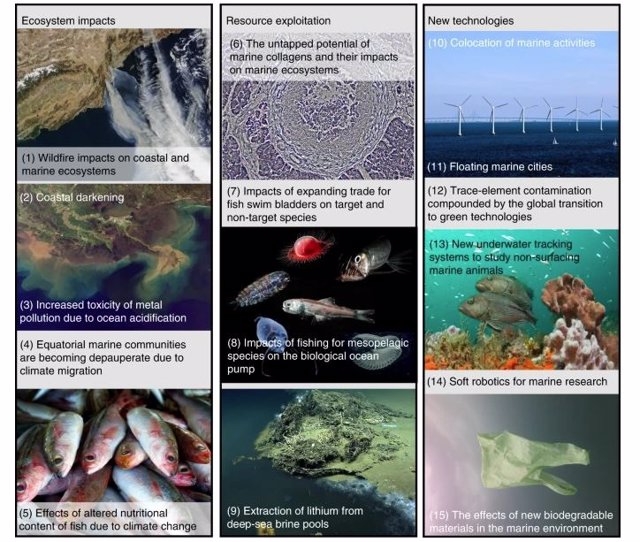Threats to marine and coastal biodiversity – HERBERT READ ET AL.
July 7. () –
An international team of experts has drawn up a list of 15 issues that, in their opinion, can have a significant impact on marine and coastal biodiversity in the next five to ten years.
Lithium extraction from the deep sea, overfishing of deeper-sea species and unexpected impacts of wildfires in the ocean on land are some of the fifteen problems that experts warn we should address now, as published in the magazine ‘Nature Ecology & Evolution’.
His technique of “horizon scan” it focuses on identifying issues that currently do not receive widespread attention, but are likely to become more important in the next decade.
The aim is to raise awareness and encourage investment in fully assessing these issues now, and potentially driving policy change, before the issues have a major impact on biodiversity.
Issues include the impact of wildfires on coastal ecosystems, the effects of new biodegradable materials on the marine environment and an “empty” zone at the equator as species move away from this warming region of the ocean.
“Marine and coastal ecosystems face a wide range of emerging issues that are poorly recognized or understood, each of which has the potential to affect biodiversity,” said Dr. James Herbert-Read of the University’s Department of Zoology. of Cambridge (United Kingdom), co-author of the article–.
By highlighting future problems, we point to where change needs to be made today – both in surveillance and in policy – to protect our marine and coastal environments.
In the exploration of the horizon, 30 experts in marine and coastal systems from 11 countries in the north and south of the world have participated, with a wide variety of profiles, including scientists and policy makers.
Several of the problems identified are related to the exploitation of ocean resources. For example, deep sea “brine pools” are unique marine environments that support a wide diversity of life and have high concentrations of lithium-containing salts.
The authors warn that the growing demand for lithium for electric vehicle batteries may endanger these environments. They demand norms that guarantee the evaluation of biodiversity before exploiting deep-water brine pools.
Although overfishing is an immediate problem, horizon scanning goes beyond this and focuses on what might happen in the future.
The authors believe that fishing will soon shift to the deeper waters of the mesopelagic zone (a depth of between 200 and 1,000 meters), where the fish are not fit for human consumption but can be sold as food to fish farms.
“We think that immediate changes could prevent big problems in the next decade, such as overfishing in the mesopelagic zone of the ocean –says Dr Ann Thornton, from the Department of Zoology at the University of Cambridge, a co-author of the paper–.

Putting a stop to this situation would not only stop the overexploitation of these fish stocks, but also reduce the disruption of the carbon cycle in the ocean, as these species are an oceanic pump that removes carbon from our atmosphere.”
The report also highlights the potential impact of new biodegradable materials on the ocean. Some of these materials are more toxic to marine species than traditional plastics.
“Governments are promoting the use of biodegradable materials, but we don’t know what impact these materials may have on ocean life,” notes Herbert-Read.
The authors also warn that the nutritional content of fish is declining as a result of climate change.
Essential fatty acids tend to be produced by cold-water fish species, so as climate change increases ocean temperatures, production of these nutritious molecules is reduced.
These changes can have repercussions on both marine life and human health. Not all the expected impacts are negative.
The authors believe that the development of new technologies, such as soft robotics and better underwater tracking systems, will allow scientists to better understand marine species and their distribution. This, in turn, will guide the development of more effective marine protected areas. But they also warn that the impact of these technologies on biodiversity must be evaluated before deploying them on a large scale.
“Our early identification of these issues and their potential impacts on marine and coastal biodiversity will help scientists, conservationists, resource managers, policy makers and the wider community address the challenges facing marine ecosystems,” says Herbert-Read.
Although there are many known problems facing ocean biodiversity, such as climate change, ocean acidification and pollution, this study focused on lesser-known emerging issues that could soon have a significant impact on marine and coastal ecosystems.
This horizon-scanning process has previously been used by researchers in the Department of Zoology to identify problems that have later come to prominence; for example, a scan carried out in 2009 warned that microplastics could become a significant problem in marine environments.
The United Nations has designated the period 2021-2030 as the United Nations Decade of Ocean Science for Sustainable Development.
In addition, the fifteenth Conference of the Parties (COP) of the United Nations Convention on Biological Diversity will conclude negotiations on a global biodiversity framework by the end of 2022.
The goal is to halt and reverse biodiversity loss and set targets for positive outcomes by 2050.


![[Img #74664]](https://thelatestnews.world/wp-content/uploads/2024/12/James-Watson-The-controversial-genius-behind-the-double-helix-150x150.jpg)








![[Img #74664]](https://thelatestnews.world/wp-content/uploads/2024/12/James-Watson-The-controversial-genius-behind-the-double-helix-300x200.jpg)


Add Comment